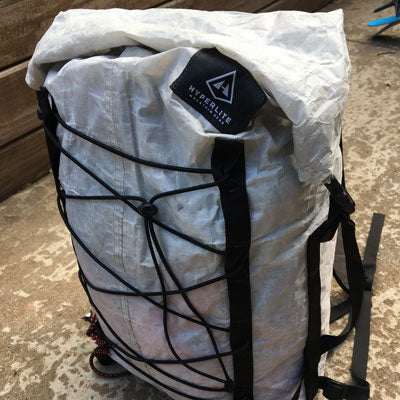
What’s in My Ski Pack? Preparing for Backcountry Skiing.
Backcountry touring is one of my favorite ways to get outside during the winter months. If the weather is good, we head above treeline and soak up the winter sun. If storms are blowing, we ski old-growth tree stands and sip hot tea. It’s hard to have a bad time playing in the snow with good friends, but being prepared with a few essentials in my pack helps guarantee that good times happen more often than not. It sucks to break a binding and post hole for miles back to the trailhead. It's also a bummer to feel a blister coming on but not have any tape to prevent it. Having a well-supplied pack keeps small issues from becoming big ones, and it also means you’re ready to handle actual emergencies. I like being prepared, but I’m also a weight weenie so I’m never going to bring the kitchen sink. I want lightweight, effective gear that I’ll actually use or need. After years of fiddling with gear, here’s a list of what I keep in my ski pack for backcountry days.
 The Pack: Hyperlite Mountain Gear Summit Pack. It’s about 30 liters of capacity and weights 0.82 pounds. This pack is not designed to carry a lot of weight or to have skis attached to it, but for general all-purpose touring, I love it.
The Pack: Hyperlite Mountain Gear Summit Pack. It’s about 30 liters of capacity and weights 0.82 pounds. This pack is not designed to carry a lot of weight or to have skis attached to it, but for general all-purpose touring, I love it.
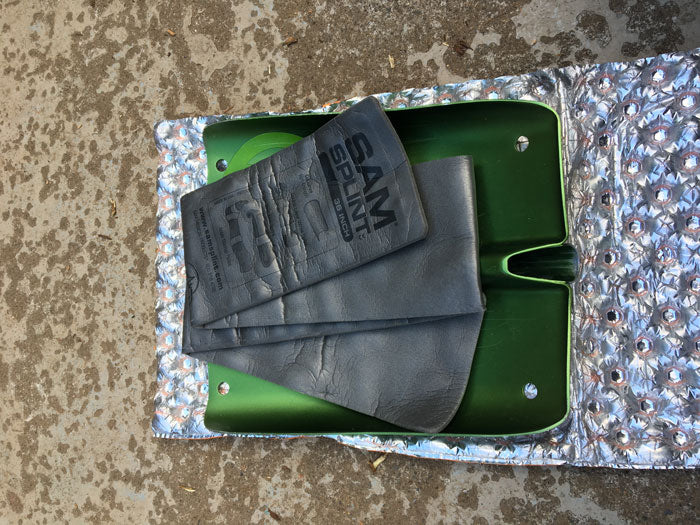 Shovel and Probe: I store my shovel handle and probe together in a corner of my backpack, next to my back. I wrap my shovel blade in a trimmed down foam pad. This protects my backpack from the blades edges and provides a padded structure that sits next to my back. I sneak a small SAM splint into this package as well. I use an old elastic band to keep the pad firmly secured to the blade. Because this sits upright, against my back, I can remove the blade very quickly to assemble the shovel if necessary. I like having a small pad to sit on at lunchtime and it doubles as splinting or padding material for rendering first aid.
Shovel and Probe: I store my shovel handle and probe together in a corner of my backpack, next to my back. I wrap my shovel blade in a trimmed down foam pad. This protects my backpack from the blades edges and provides a padded structure that sits next to my back. I sneak a small SAM splint into this package as well. I use an old elastic band to keep the pad firmly secured to the blade. Because this sits upright, against my back, I can remove the blade very quickly to assemble the shovel if necessary. I like having a small pad to sit on at lunchtime and it doubles as splinting or padding material for rendering first aid.
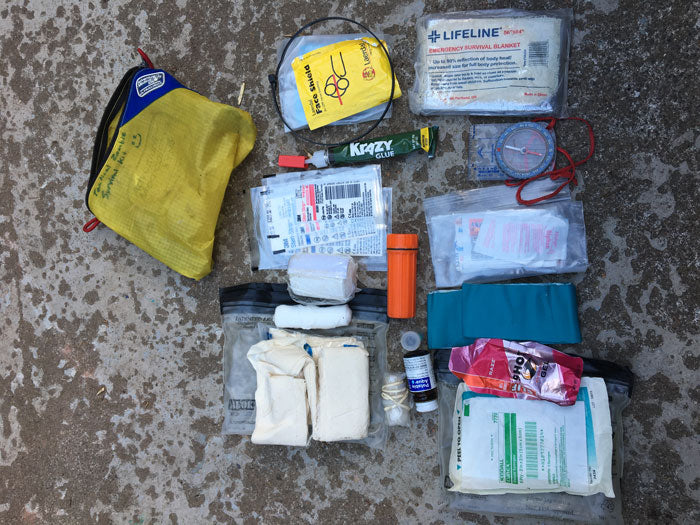 First Aid Kit: I carry a small first aid kit that’s augmented with a few things. Besides the regular assortment of bandages and gauze pads, I make sure I’ve got some basic medications like Benadryl and aspirin. These are invaluable in certain medical situations. I also throw in one or two gels in case of diabetic emergencies or unexpected bivis. I carry some waterproof matches, Iodine tablets for treating water, an emergency blanket, and a compass. The extra goodies I’ve recently added are a big roll of duct tape, a zip-tie, some super glue, and Steri-strips. And I always include a face shield and pair of gloves, which are packed last, so they are on top.
First Aid Kit: I carry a small first aid kit that’s augmented with a few things. Besides the regular assortment of bandages and gauze pads, I make sure I’ve got some basic medications like Benadryl and aspirin. These are invaluable in certain medical situations. I also throw in one or two gels in case of diabetic emergencies or unexpected bivis. I carry some waterproof matches, Iodine tablets for treating water, an emergency blanket, and a compass. The extra goodies I’ve recently added are a big roll of duct tape, a zip-tie, some super glue, and Steri-strips. And I always include a face shield and pair of gloves, which are packed last, so they are on top.
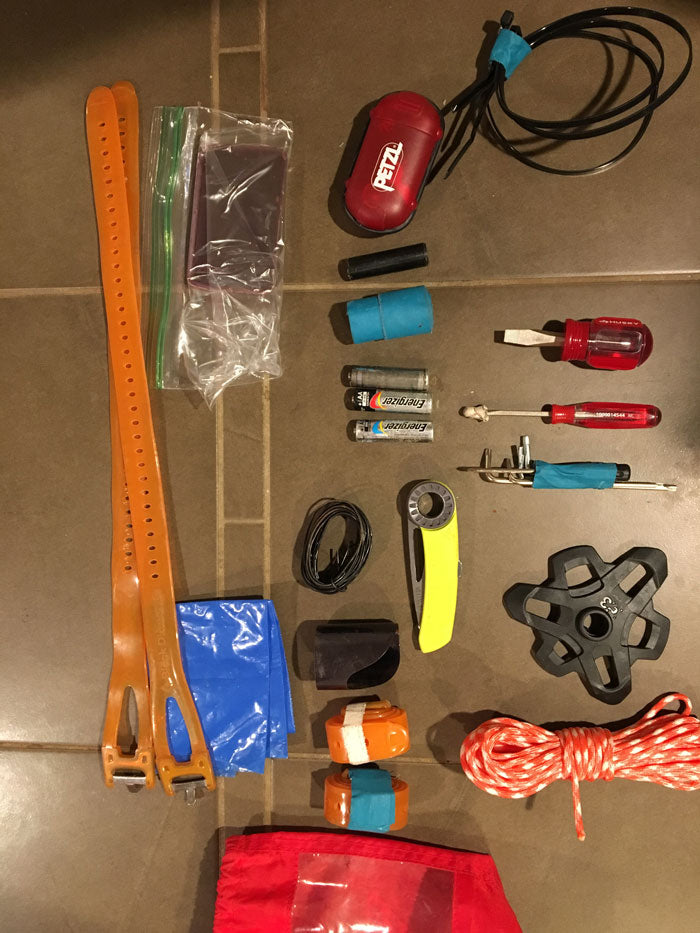 Ski Repair Kit: These things always come with me when I’m skiing and many of them still come with me during non-ski-related, summertime trips. Skis straps are so versatile and handy for all sorts of problems that I carry 3-4 with me. I also carry a small knife and several screwdrivers and wrenches that I need for binding and boot adjustments. Take a look at your bindings and boots and see what you might need to tighten things down. Other handy repairs items include more zip-ties, metal wire (rebar wire), and duct tape. I also bring some gaffers tape; it has similar strength to duct tape but no sticky residue. An extra, lightweight headlamp and spare batteries are crucial as is a back-up pair of sunglasses. I carry the small, rollable ones you can get at the optometrists office. You’ll never break these, and they work in a pinch. Not being able to see in the mountains, either due to darkness or snow blindness, goes from annoying to dangerous really quickly.
Ski Repair Kit: These things always come with me when I’m skiing and many of them still come with me during non-ski-related, summertime trips. Skis straps are so versatile and handy for all sorts of problems that I carry 3-4 with me. I also carry a small knife and several screwdrivers and wrenches that I need for binding and boot adjustments. Take a look at your bindings and boots and see what you might need to tighten things down. Other handy repairs items include more zip-ties, metal wire (rebar wire), and duct tape. I also bring some gaffers tape; it has similar strength to duct tape but no sticky residue. An extra, lightweight headlamp and spare batteries are crucial as is a back-up pair of sunglasses. I carry the small, rollable ones you can get at the optometrists office. You’ll never break these, and they work in a pinch. Not being able to see in the mountains, either due to darkness or snow blindness, goes from annoying to dangerous really quickly.
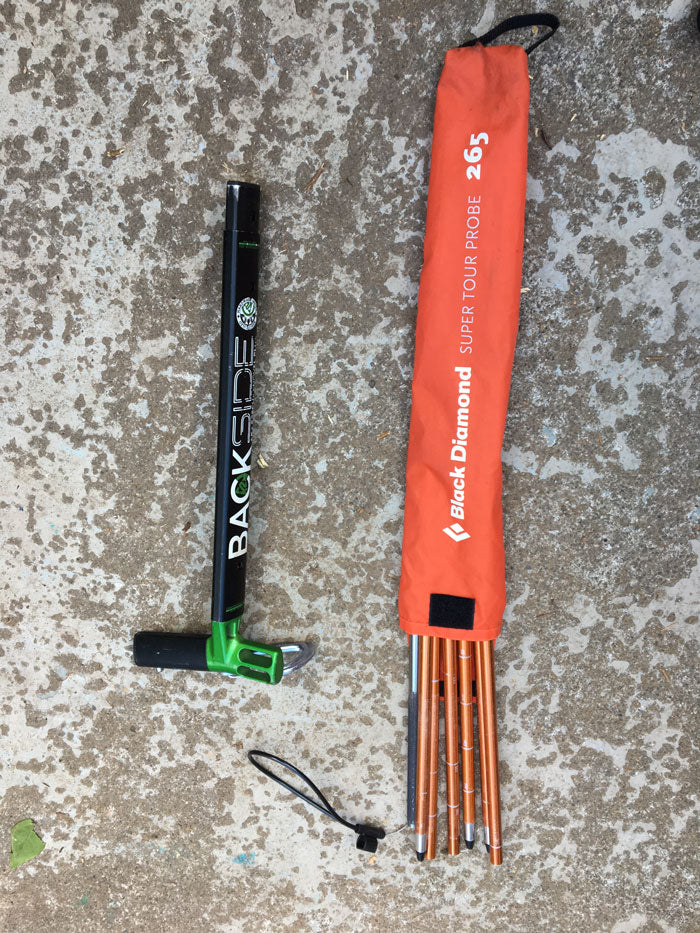 I include about 15’ of orange cord. This has multiple uses but can also help you see contours in the snow in flat light conditions when tied to a ski pole and “cast” out in front. Skin wax is always nice to have, especially in the Spring. I can’t stand it when snow starts to ball on the bottom of my skins. And lastly, a wag bag, because you never want to leave that trace.
Take some time this winter to assemble a good kit for backcountry touring. Having just a few essential items can save the day. Even if you don’t ever use them, your friends will thank you! And if an unexpected disaster actually does strike, you’ll be ready to jump in and help out.
I include about 15’ of orange cord. This has multiple uses but can also help you see contours in the snow in flat light conditions when tied to a ski pole and “cast” out in front. Skin wax is always nice to have, especially in the Spring. I can’t stand it when snow starts to ball on the bottom of my skins. And lastly, a wag bag, because you never want to leave that trace.
Take some time this winter to assemble a good kit for backcountry touring. Having just a few essential items can save the day. Even if you don’t ever use them, your friends will thank you! And if an unexpected disaster actually does strike, you’ll be ready to jump in and help out.
 The Pack: Hyperlite Mountain Gear Summit Pack. It’s about 30 liters of capacity and weights 0.82 pounds. This pack is not designed to carry a lot of weight or to have skis attached to it, but for general all-purpose touring, I love it.
The Pack: Hyperlite Mountain Gear Summit Pack. It’s about 30 liters of capacity and weights 0.82 pounds. This pack is not designed to carry a lot of weight or to have skis attached to it, but for general all-purpose touring, I love it.
 Shovel and Probe: I store my shovel handle and probe together in a corner of my backpack, next to my back. I wrap my shovel blade in a trimmed down foam pad. This protects my backpack from the blades edges and provides a padded structure that sits next to my back. I sneak a small SAM splint into this package as well. I use an old elastic band to keep the pad firmly secured to the blade. Because this sits upright, against my back, I can remove the blade very quickly to assemble the shovel if necessary. I like having a small pad to sit on at lunchtime and it doubles as splinting or padding material for rendering first aid.
Shovel and Probe: I store my shovel handle and probe together in a corner of my backpack, next to my back. I wrap my shovel blade in a trimmed down foam pad. This protects my backpack from the blades edges and provides a padded structure that sits next to my back. I sneak a small SAM splint into this package as well. I use an old elastic band to keep the pad firmly secured to the blade. Because this sits upright, against my back, I can remove the blade very quickly to assemble the shovel if necessary. I like having a small pad to sit on at lunchtime and it doubles as splinting or padding material for rendering first aid.
 First Aid Kit: I carry a small first aid kit that’s augmented with a few things. Besides the regular assortment of bandages and gauze pads, I make sure I’ve got some basic medications like Benadryl and aspirin. These are invaluable in certain medical situations. I also throw in one or two gels in case of diabetic emergencies or unexpected bivis. I carry some waterproof matches, Iodine tablets for treating water, an emergency blanket, and a compass. The extra goodies I’ve recently added are a big roll of duct tape, a zip-tie, some super glue, and Steri-strips. And I always include a face shield and pair of gloves, which are packed last, so they are on top.
First Aid Kit: I carry a small first aid kit that’s augmented with a few things. Besides the regular assortment of bandages and gauze pads, I make sure I’ve got some basic medications like Benadryl and aspirin. These are invaluable in certain medical situations. I also throw in one or two gels in case of diabetic emergencies or unexpected bivis. I carry some waterproof matches, Iodine tablets for treating water, an emergency blanket, and a compass. The extra goodies I’ve recently added are a big roll of duct tape, a zip-tie, some super glue, and Steri-strips. And I always include a face shield and pair of gloves, which are packed last, so they are on top.
 Ski Repair Kit: These things always come with me when I’m skiing and many of them still come with me during non-ski-related, summertime trips. Skis straps are so versatile and handy for all sorts of problems that I carry 3-4 with me. I also carry a small knife and several screwdrivers and wrenches that I need for binding and boot adjustments. Take a look at your bindings and boots and see what you might need to tighten things down. Other handy repairs items include more zip-ties, metal wire (rebar wire), and duct tape. I also bring some gaffers tape; it has similar strength to duct tape but no sticky residue. An extra, lightweight headlamp and spare batteries are crucial as is a back-up pair of sunglasses. I carry the small, rollable ones you can get at the optometrists office. You’ll never break these, and they work in a pinch. Not being able to see in the mountains, either due to darkness or snow blindness, goes from annoying to dangerous really quickly.
Ski Repair Kit: These things always come with me when I’m skiing and many of them still come with me during non-ski-related, summertime trips. Skis straps are so versatile and handy for all sorts of problems that I carry 3-4 with me. I also carry a small knife and several screwdrivers and wrenches that I need for binding and boot adjustments. Take a look at your bindings and boots and see what you might need to tighten things down. Other handy repairs items include more zip-ties, metal wire (rebar wire), and duct tape. I also bring some gaffers tape; it has similar strength to duct tape but no sticky residue. An extra, lightweight headlamp and spare batteries are crucial as is a back-up pair of sunglasses. I carry the small, rollable ones you can get at the optometrists office. You’ll never break these, and they work in a pinch. Not being able to see in the mountains, either due to darkness or snow blindness, goes from annoying to dangerous really quickly.
 I include about 15’ of orange cord. This has multiple uses but can also help you see contours in the snow in flat light conditions when tied to a ski pole and “cast” out in front. Skin wax is always nice to have, especially in the Spring. I can’t stand it when snow starts to ball on the bottom of my skins. And lastly, a wag bag, because you never want to leave that trace.
Take some time this winter to assemble a good kit for backcountry touring. Having just a few essential items can save the day. Even if you don’t ever use them, your friends will thank you! And if an unexpected disaster actually does strike, you’ll be ready to jump in and help out.
I include about 15’ of orange cord. This has multiple uses but can also help you see contours in the snow in flat light conditions when tied to a ski pole and “cast” out in front. Skin wax is always nice to have, especially in the Spring. I can’t stand it when snow starts to ball on the bottom of my skins. And lastly, a wag bag, because you never want to leave that trace.
Take some time this winter to assemble a good kit for backcountry touring. Having just a few essential items can save the day. Even if you don’t ever use them, your friends will thank you! And if an unexpected disaster actually does strike, you’ll be ready to jump in and help out.

